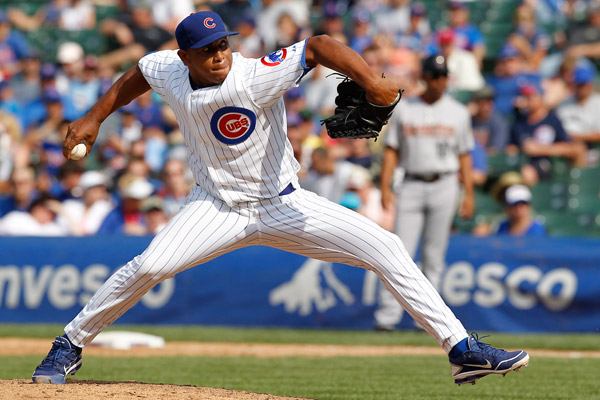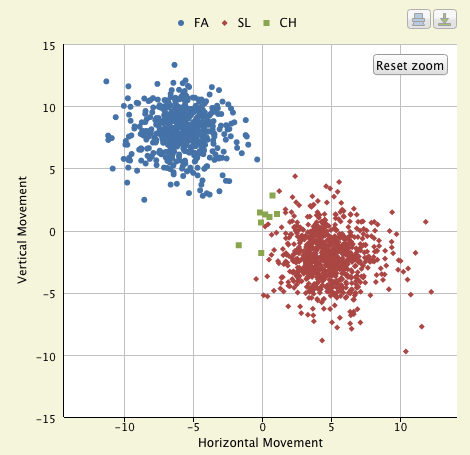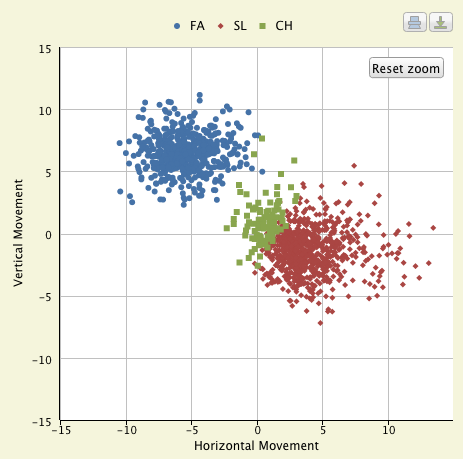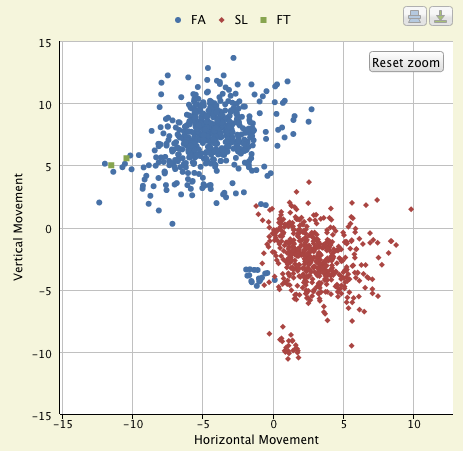
José M. Osorio/Chicago Tribune
For my fantasy baseball auction this year, instead of pursuing Carlos Marmol, I decided to stash Kyuji Fujikawa on my bench under the assumption that he would be the Cubs' closer sooner rather than later. On opening day he vultured a save from Marmol. Six games in, he has replaced Marmol full time.
Despite a rough outing Saturday—three runs on four hits and a walk, which paved the way for Marmol's blown save—Fujikawa looks to be a better reliever than Rafael Dolis, who replaced Marmol last year (despite being worse at everything Marmol is bad at).
What's believed to be killing Marmol is his slider. It has been flat, as Dale Sveum has pointed out:
Marmol also has shown a pattern that scouts are probably picking up. He throws first-pitch fastballs to batters 80 percent of the time, and when he's ahead in the count, he'll go to his slider 75 percent of the time. If he has two strikes, he'll also throw his slider 90.9 percent.
Here's how Marmol's slider and fastball used to work in tandem, and how they work now. In 2009, when Marmol was emerging as an elite closer—just a season before his best one in the majors—Harry Pavlidis wrote:
Carlos Marmol, on the other hand, with his slurvey slider, which we now know actually does have greater-than-gravity sink on it, also gets some real break or sweep. [Randy] Johnson's slider gets virtually no lateral spin movement, hence the straight line, and [Brad] Lidge gets about a half an inch. Marmol, on the other hand, spins the ball such that it acquires over 5 inches of movement from the spin.
[snip]
Even with a half-foot of sweep on his slider, Marmol's breaking pitch is no match for his fastball, which tails almost an inch more, and in the opposite direction. Relatively speaking, that's over a foot difference in break.
In 2010, Marmol's slider and fastball were moving a lot. Marmol's slider tended to move around five inches horizontally; his fastball, around 5-10 inches horizontally.

If you follow it over the next couple years, you can see the pitches move less. The two location maps below move ever closer towards the zero-motion dead center.
In 2011, the next year, Marmol's ERA ballooned from 2.55 to 4.01; his strikeouts fell from 138 to 99 despite pitching only 3.2 fewer innings. His velocity also declined—from 94.1 mph to 91.8 mph. And as you can see, his slider was not moving.

In 2012, he got his velocity back (94.1 on his fastball). But both pitches were moving less than they were in 2010.

And while it's an extremely tiny sample size, this year, Marmol hasn't thrown a single fastball or slider that moved more than five horizontal inches.
What else seems to have happened with Marmol is not so much that his control has gotten worse (though it has a bit). It's that he's not fooling batters like he used to.
* In 2010, 47.1 percent of Marmol's pitches were in the strike zone. From 2011-2013, it went from 45.1 percent to 43.6 percent and back up to 46.2 percent.
* In 2010, batters swung at 27.7 percent of pitches outside the strike zone. That statistic fell to 25.9, 22.0, and 14.3 percent.
* Batters swung at pitches inside the strike zone 50.9 percent of the time in 2010; that rose to 56.7 percent, then fell back to 53.8 and rose slightly to 54.2.
* Now, the big difference is that batters started hitting those pitches. Hitters' contact rates rose from 61.3 percent in 2010 to 71.3, 74.2, and 82.4 percent. Swinging strike rate dropped from 14.4 percent in 2010 to 11.2 percent, 9.1 percent, and this year, 5.8 percent.
A 14.4 percent swinging strike rate is elite; if he'd maintained that rate last year, Marmol would have tied for 9th in the league with current closers Jason Grilli and Ernesto Frieri. 9.1 percent was good for only 156th out of 325 pitchers who pitched at least 50 innings. A 61.3 percent contact rate would have been just 0.01 percent less than Craig Kimbrel, the most fearsome closer in baseball.
Sveum wants Marmol to rely more on his fastball, but that's what he's been doing. Last year Marmol threw about half sliders and half fastballs, compared to 2010, when he threw about 60/40 sliders/fastballs. And his fastball—which used to break a lot—hasn't been breaking either.
Marmol has two pitches, so the obvious short-term solution is to change their mix. But if both pitches are moving less, the only real solution will be a long-term one.


